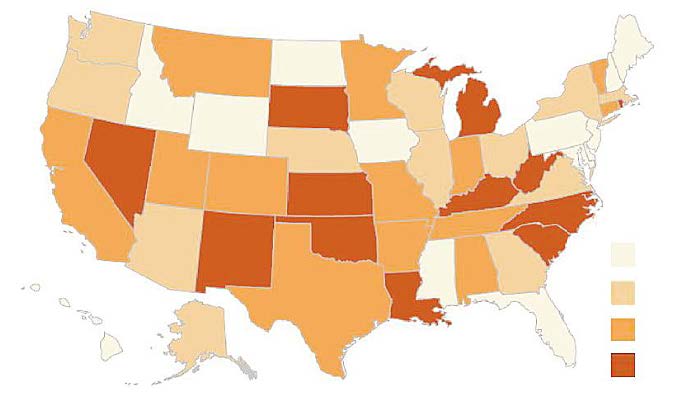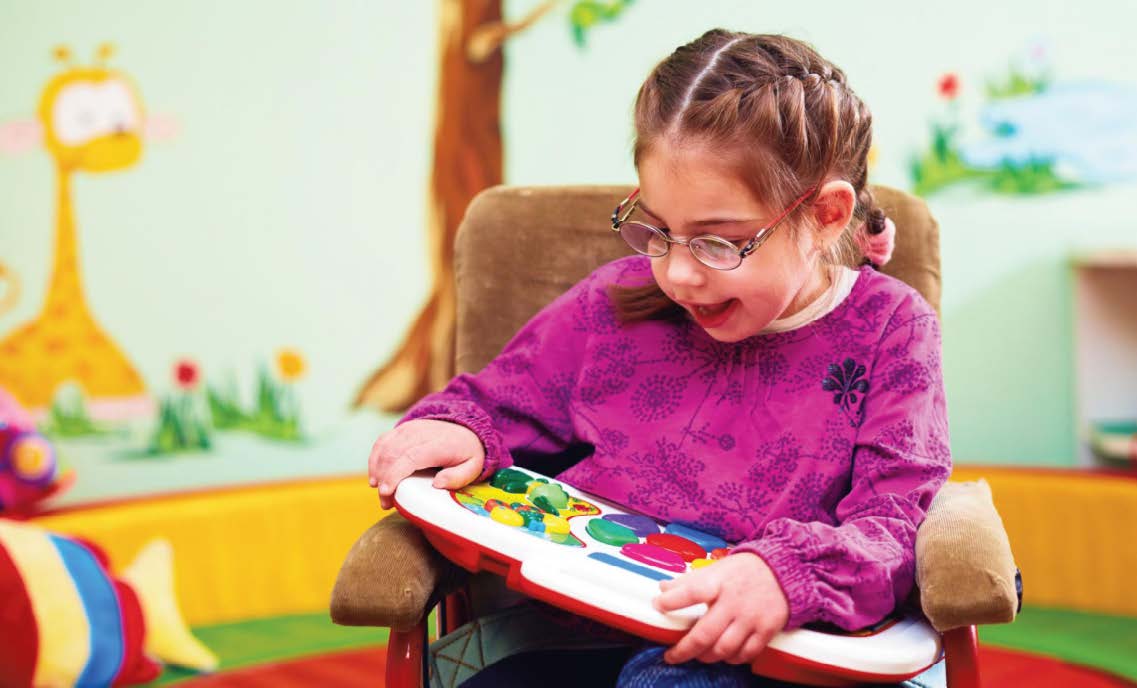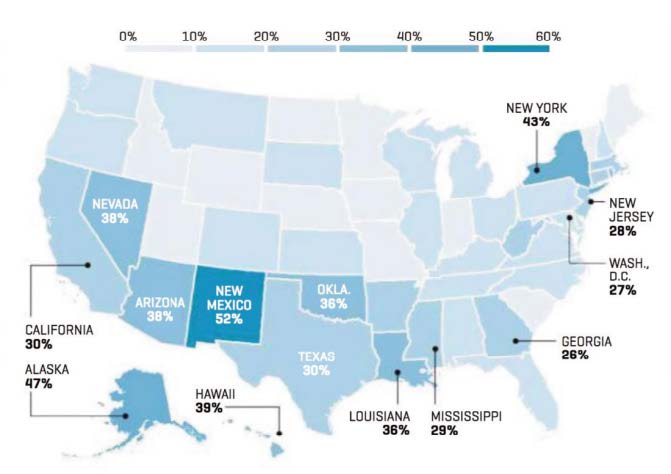Surely There Are More Than About 155,000 Children Less Than 5 Years of Age with Disabilities in the U.S.
BY H. BARRY WALDMAN, DDS, MPH, PHD, STEVEN P. PERLMAN, DDS, MSCD, DHL (HON) AND CHARLES D. LARSEN, DMD, MS
ONLY 154,569 CHILDREN?
The U.S. Census Bureau's annual American Community Survey lists demographic findings for an extensive range of factors related to the civilian noninstitutionalized population; including the estimated number for 2016 (39.3 million residents) and the percent (12.5%) of the population with severe types of disabilities by age, gender, race and Hispanic origin.1
The estimated number of individuals with severe disabilities range from 56,630 Native Hawaiian and other Pacific Islanders alone, to 26,748,346 white alone, not Hispanic or Latino. The proportion with disabilities range from 6.9% for Asians alone to 16.6% for American Indian and Alaska Native alone.
There is a progressive increase by age in the proportion of individuals with disabilities from 0.8% of the 19,865,233 for children less than five years of age (154,569 youngsters with disabilities) to 50% of the 18.8 million individuals of the 75 years and older (9.4 million with disabilities).
In 2016, the proportion of youngsters less than 5 years with disabilities in every state was 2.8% or less. The states with the highest percentages were Nevada (2.8%) and Rhode Island (2.1%). Forty states had percentages equal to or less than 1.0%.2 (See Figure 1)
In 2016, the five states with the greatest number of youngsters less than 5 years with disabilities were: California - 18,595 Texas - 14,498 New York - 6,542 N. Carolina - 6,172 Florida - 6,149 3
But, while the American Community Survey report includes estimated data for six disability categories (hearing, vision, cognitive, ambulatory, self-care and independent living difficulties) for individuals five years and older, information for children less than five years is available for only hearing difficulties (103,920 very young children) and vision difficulties (91,697 very young children).
AMERICAN ACADEMY OF DEVELOPMENTAL MEDICINE AND DENTISTRY The American Academy of Developmental Medicine and Dentistry (AADMD) was organized in 2002 to provide a forum for healthcare professionals who provide clinical care to people with neurodevelopmental disorders and intellectual disabilities (ND/ID). The mission of the organization is to improve the quality and assure the parity of healthcare for individuals with neurodevelopmental disorders and intellectual disabilities throughout the lifespan.
Notes: 1. The estimated number of children less than five years of age with hearing or vision difficulties is recorded as one child in the two separate categories (103,920 + 91,697 = 195,617 very young children) which is greater than the overall number of 154,569 children with these two disability categories. The difference occurs as a result when a child with both disabilities is listed as one child with disabilities.
2. In part, the hesitancy to include data for additional disability types may be related to the limited ability to properly diagnose conditions for youngsters at such an early age.
GLOBAL BURDEN OF DISEASE STUDY
Actually, almost 810,000 children less than 5 years of age with disabilities were reported in the USA 4
"Globally, 52.9 million… or 8.4%... of children younger than 5 years (54% males) had developmental disabilities in 2016, compared with 53.9 million… in 1990. About 95% of these children lived in low-income and middle-income coun tries... Vision loss was the most prevalent disability, followed by hearing loss, intellectual disability, and autism spectrum disorder (emphasis added)… the prevalence of developmental disabilities among children younger than 5 years decreased in all countries (except in North America – emphasis added) between 1990 and 2016)…South Asia had the highest prevalence of chil dren with developmental disabilities in 2016 and North America had the lowest." 4

Results from the Global Burden of Disease Study (GBD) indicated that in 2016, for the United States, there were an estimated 809,661 children less than five years of age with disabilities and 4,117 children with disabilities per 100,000 population less than five years of age. "Early childhood… is the fastest period of growth and the period in which the developing brain is most sensitive to stimulation and nurturing. The period of development is regarded as the foundation for subsequent educational and vocational attainment at the individual level…Developmental disabilities are a group
of conditions resulting from impairments that affect a child's physical, learning, or behavioral functions. Affected children typically have sensory impairment (hearing and vision loss, [are reported in the U.S. Census Bureau's annual American Community Survey]). Epilepsy or seizures, cerebral palsy, attention deficit hyperactivity disorder (ADHD), autism spectrum disorder (ASD), intellectual disability or other learning disorders (are not reported in the American Community Survey for children less than five years of age)." 4
The GBD study concept, first published in 1996, constitutes the most comprehensive and consistent set of estimates of death and illness. The World Health Organization now regularly develops GBD estimates at regional and global levels of a set of more than 135 causes of disease and injury. A GBD study aims to quantify the burden of premature mortality and disability and uses a summary measure of population health to combine estimates of the years of life lost and the years lived with disabilities.5
DOES THE REPEATED, PUBLISHED UNDER-COUNT OF THE NUMBER OF CHILDREN LESS THAN AGE FIVE WITH DISABILITIES REALLY MATTER?
That is like asking whether it matters that hundreds of thousands (or more) of eligible residents do not vote in particular elections. Numbers do count, in terms of efforts to bring about change, and how to plan for the results of needed change. The estimated number of very young children with disabilities reported by Global Burden of Disease Study is more than five times the estimated number reported by the U.S. Census Bureau's annual American Community Survey (809,661 vs. 154,569 very young children with disabilities).
The introduction of these dramatic numbers can only increase the pressure for additional funds for services to reach more than three-quarters of a million very young children with disabilities. Surely, the widespread awareness of the magnitude of the numbers will generate increased incentives for needed training and service programs for the next generations of health practitioners to provide for these youngsters.
P.S. Adding to the difficulties in accurately determining the full extent of children with varying types of disabilities among children less than five years of age, is the reality of the "Census Snafu. Nearly one in four (sic) children under the age of 5 in the U.S. lives in an area at risk of being missed by census employees in 2020, according to the Annie E. Casey Foundation's annual Kids Count Data Book… (Due to) language barriers, high poverty level, distrust of government and households with mixed immigration statuses, make collecting accurate counts challenging for the Census Bureau. An inaccurate count means fewer federal dollars going to those states and a direct blow to the quality of education and health care that state governments can provide." 6 The share of children less than five years at risk of being undercounted in the 2020 census ranges as high as: 30% in California, 38% in Louisiana, 39% in Hawaii, 43% in New York, 47% in Alaska and 52% in New Mexico. (See Figure 2)6
So why not encourage the use of available disability data for very young children while recognizing that it is in a preliminary format. For example: in an earlier report (for 2002) the Census Bureau reported that, among: • "11.3 million children under 3 years, developmental delay and/or difficulty moving their arms or legs was found among 2 percent of children in this age group. • 11.6 million children age 3 to 5… 4 percent had one or both of the following conditions: a developmental delay or an activity limitation involving walking, running or playing." 7•

NUMBERS COUNT: Does undercounting really matter? The estimated number of very young children with disabilities reported by Global Burden of Disease Study is more than five times the estimated number reported by the U.S. Census Bureau's annual American Community Survey.

ABOUT THE AUTHORS: H. Barry Waldman, DDS, MPH, PhD is a SUNY Distinguished Teaching Professor, Department of General Dentistry, Stony Brook University, NY. E-mail: h.waldman@stonybrook.edu Steven P. Perlman, DDS, MScD, DHL (Hon) is the Global Clinical Director and founder, Special Olympics, Special Smiles and Clinical Professor of Pediatric Dentistry, The Boston University Goldman School of Dental Medicine. Charles D. Larsen, DMD, MS is Assistant Professor; Director, Advanced Specialty Education in Pediatric Dentistry, Department of Orthodontics & Pediatric Dentistry at Stony Brook University, NY.
References 1. Census Bureau. Disability Characteristics 2012-2016 American Community Survey 5-year estimates. Available from: https//factfind er.census.gov/facers/tableservices/jsf/pages/productview.xhtml? pid=ACS_16_5YR_S1810&prodType=tablebleable Accessed September 1, 2018. 2. Kraus L, Lauer E, Coleman R, Houtenville A. (2018). 2017 Disability Statistics Annual Report. Durham, NH: University of New Hampshire. Available from: disabilitycompendium.org/sites/default/files/user- uploads/2017_AnnualReport_2017_FINAL.pdf Accessed September 3, 2018. 3. Institute on Disability, University of New Hampshire. 2017 Annual Disability Statistics Supplement. Available at: disabili- tycompendium.org/sites/default/files/user- uploads/CompendiumSupplement_2017_Final.pdf Accessed September 4, 2018. 4. Global Research on Developmental Disabilities. Developmental disabilities among children younger than 5 years in 195 countries and territories, 1990-2016; a systematic analysis for the Global Burden of Disease Study 2016. Available from: the- lancet.com/journals/langlo/article/PIIS2214-109X(18)30309-7/fulltext Access September 1, 2018. 5. Murray CJL, Lopez AD. Measuring the global burden of disease. New England Journal of Medicine, 2013; 369:448-457. 6. Donnelly G. Do you know where the children are? Fortune; 2018; September: 20 7. Census Bureau. American with disabilities in 2002. Available from: census.gov/population/pop- profile/dynamic/Disability.pdf